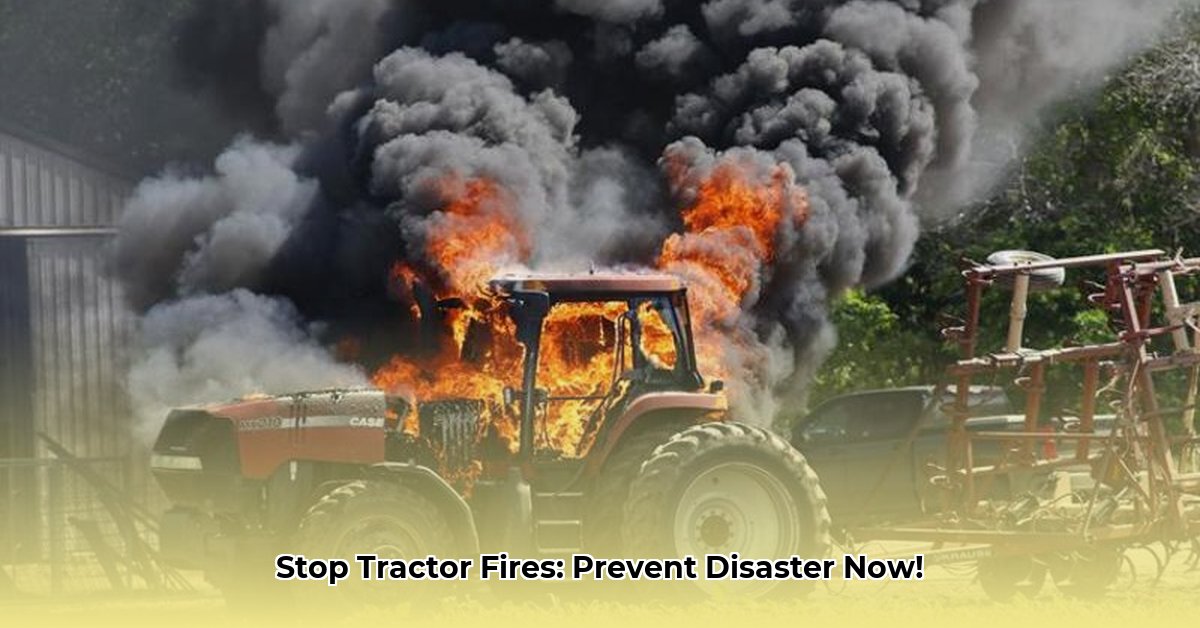
Understanding Tractor Fires: Causes and Prevention
Tractor fires are a serious threat to farmers, causing significant property damage and posing safety risks. Fortunately, many tractor fires are preventable through diligent maintenance and safe operating practices. This guide provides actionable steps to mitigate risks and respond effectively in case of a fire.
Common Causes of Tractor Fires
Most tractor fires (approximately 75%) originate in the engine compartment due to the concentration of heat, flammable liquids (fuel and oil), and electrical components. Key causes include:
- Dirty Engine Compartments: Dust, debris, and spilled fluids create a readily combustible environment. Regular cleaning is essential.
- Electrical Issues: Faulty wiring, short circuits, and damaged electrical components can easily ignite. Regular electrical system checks are crucial.
- Fuel Leaks and Spills: Fuel is highly flammable. Even small leaks near heat sources can cause ignition. Regularly inspect and repair all fuel lines and connections.
- Overheating: An overheated engine is a significant fire hazard, often exacerbated by inadequate ventilation. Ensure proper airflow within the engine compartment.
- Improper Fuel Handling: Careless refueling practices (e.g., smoking near fuel) increase fire risks. Always turn off the engine before refueling.
- Spontaneous Combustion: Improperly stored or dried materials like hay can spontaneously combust due to internal heating. Ensure proper ventilation, moisture control, and storage of such materials. High temperatures exceeding 150°F inside hay bales are particularly dangerous.
Preventing Tractor Fires: A Step-by-Step Guide
This section outlines a comprehensive action plan to minimize the risk of tractor fires. Following these steps significantly reduces your risk.
1. Regular Cleaning: Thoroughly clean your tractor, especially the engine compartment, regularly. Remove dust, debris, oil, grease, and other flammable materials. Consider pressure washing at the start of each season. (Note: This simple step drastically reduces fuel for a fire.)
2. Electrical System Inspection: Regularly inspect your tractor's electrical system for frayed wires, loose connections, or damage. Replace damaged parts immediately. (Note: Addressing electrical issues promptly prevents short circuits and potential ignition.)
3. Fuel System Checkup: Inspect fuel lines, tanks, hoses, and connections at the start of each work session. Tighten loose connections. Repair or replace any damaged parts. Check for leaks regularly. (Note: Timely leak detection and repair prevent fuel-related fires.)
4. Fire Extinguisher Availability: Keep at least one 10-pound or larger ABC-type fire extinguisher readily accessible on your tractor. Ensure it's fully charged and that you know how to use it. (Note: A readily available and properly used fire extinguisher can suppress small fires before they escalate.)
5. Operator Training: Ensure all operators receive thorough training on proper tractor operation, emergency procedures, and fire extinguisher use. (Note: Proper training reduces the likelihood of operator errors that can lead to fires.)
6. Scheduled Maintenance: Regular maintenance is crucial. Schedule routine inspections and servicing according to the manufacturer's recommendations. (Note: Preventative maintenance identifies and rectifies potential fire hazards before they become serious problems.)
7. Consult Your Manual: Carefully review your tractor's owner's manual for specific maintenance instructions and safety guidelines. (Note: Manufacturer's guidelines offer crucial information on preventative maintenance specific to your tractor model.)
Responding to a Tractor Fire: Emergency Procedures
If a fire starts, prioritize your safety. Follow these steps:
1. Immediate Evacuation: Evacuate the tractor immediately and move to a safe distance. (Note: Your safety is paramount. Do not risk injury trying to fight a fire within the tractor.)
2. Emergency Services: Call emergency services (911 in the US) immediately. Provide your location and a description of the situation.
3. Fire Extinguisher Use (If Safe): If the fire is small and you can safely approach it, use your fire extinguisher. If unsure, do not attempt to extinguish the fire yourself. (Note: Extinguishers are effective on small fires but not large or rapidly spreading ones.)
Risk Assessment and Mitigation
This matrix clarifies the risks associated with tractor fires and emphasizes proactive mitigation strategies:
| Risk Factor | Probability (High/Medium/Low) | Severity (High/Medium/Low) | Mitigation Strategies |
|---|---|---|---|
| Poor Cleaning | High | High | Regular cleaning, pressure washing, prompt removal of spills. |
| Electrical System Malfunction | Medium | High | Regular inspections, prompt repairs, replacement of worn components. |
| Fire Extinguisher Unavailability | Medium | High | Regular inspections, proper maintenance, operator training on extinguisher use. |
| Inadequate Operator Training | High | Medium | Comprehensive training programs covering safe operation and emergency procedures. |
| Worn or Damaged Components | Medium | High | Regular maintenance, prompt component replacement, adherence to manufacturer's guide. |
Regulatory Compliance
Familiarize yourself with local fire safety regulations and insurance requirements. These vary depending on your location. Contact local authorities or your insurance provider for specific information.
Key Takeaway: Proactive maintenance, regular inspections, comprehensive training, and swift action are crucial for preventing and responding to tractor fires. Prioritize your safety and the safety of others.